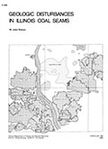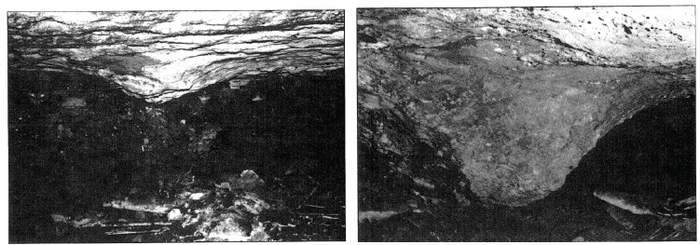Circular 530 Limestone Bosses
| Geologic Disturbances in Illinois Coal Seams | ||||||||||
|---|---|---|---|---|---|---|---|---|---|---|
| Channels | Split Coal | Rolls | Limestone Bosses | Clay Dikes | White Top | Igneous Dikes | Joints | Coal Balls | Miscellaneous Disturbances | Acknowledgments |
Limestone Bosses
Boss is a mining term for a large bulge of roof rock, usually limestone, protruding into the upper layers of a coal seam. Although something like a roll, a boss is round or irregular in map view rather than linear, and is always connected to the roof.
Typical bosses range from a few feet to more than 10 feet across and can extend several feet downward into the coal (fig. 30). The coal directly below a boss is squeezed downward, but the bottom of the seam is not affected. Some bosses occur where shale lies between the coal and the limestone. In this case, the shale is broken and forced aside, while only the topmost coal is disturbed. Apparently, bosses formed from downward slumping of limy sediments before they hardened, not from erosion.
Features similar to limestone bosses occur under sandstone roof at the Freeman United Crown ll Mine in Macoupin County. Small sandstone bulges are found along an Anvil Rock channel on the north side of the mine. Larger but less abrupt bulges are scattered throughout the mine in areas where sandstone lies close to the top of the coal. Most are round or oval in map view and range from 10 to 30 feet in diameter. Coal is only slightly thinned and deformed underneath the bulges.
Mining problems.
Bosses are common features in many underground mines but seldom more than a nuisance. Occasionally, miners must work around a large boss in the coal. Shale around the edges of a boss normally is fractured and weakened, so it may fall from the roof; but the boss itself is solidly attached to the main layer of limestone. Sandstone bulges do not interfere with mining; but the areas in which they occur are often very wet, and roof control is difficult.


